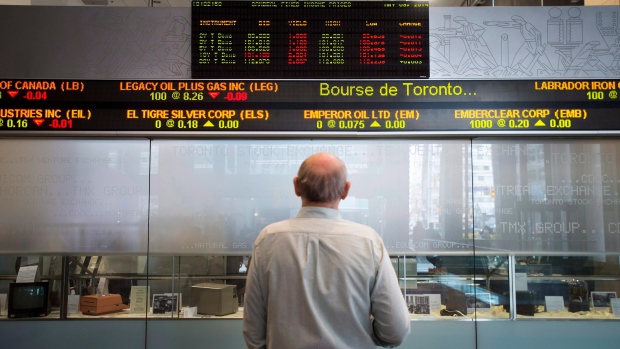Mar 23, 2018
Dow closes down 400-plus points; TSX hits 5-week low
Reuters

Wall Street tumbled on Friday with more than 1,000 points knocked off the Dow in two days as investors, increasingly nervous about a potential U.S. trade war with China, shied away from risk ahead of the weekend and sought shelter from further losses.
In a volatile session, the S&P 500 came within a hair of its 200-day moving average, a key technical level. The benchmark index also nudged closer to its February low, which marked a correction, ending 9.9 per cent lower than its Jan. 26 record.
"There is concern what the trade war could look like. Investors want to manage their risk. If it escalates rapidly, it could be a major headwind for the market," said Peter Kenny, senior market strategist at Global Markets Advisory Group, in New York.
President Donald Trump's plans for tariffs on up to US$60 billion in Chinese goods moved the world's two largest economies closer to a trade war as China declared plans to levy duties on up to US$3 billion of U.S. imports including fruit and wine even as it urged the United States to "pull back from the brink."
The Dow Jones Industrial Average fell 424.69 points, or 1.77 per cent, to 23,533.2, the S&P 500 lost 55.43 points, or 2.10 per cent, to 2,588.26 after hitting an intraday low that was barely above its 200-day moving average of 2585.22.
The Nasdaq Composite dropped 174.01 points, or 2.43 per cent, to 6,992.67.
For the week, the Dow was down 5.67 per cent, the S&P 500 was down 5.95 per cent and the Nasdaq was down 6.54 per cent, marking their biggest weekly percentage falls since January 2016.
The Dow was down 11.6 per cent since its Jan. 26 high, and hit its lowest close since confirming a correction in February.
The Cboe Volatility Index, the most widely followed barometer of expected near-term volatility in the S&P 500, finished up 1.53 points at 24.87, its highest close since Feb. 13.
The S&P's financial sector was the S&P's biggest percentage loser, at 3 per cent, after a volatile session in which it was whip-sawed by volatile Treasury yields.
Bloomberg News cited China’s ambassador to the United States saying that the country is “looking at all options” in response to tariffs, which could include scaling back purchases of U.S. Treasuries.
Nasdaq was weighed down by declines in momentum stocks such as Facebook, Amazon.com, Microsoft and Google's parent Alphabet.
The semiconductor sector took a fall after Micron Technology's quarterly report stoked fears about falling NAND prices. The Philadelphia Semiconductor index slumped 3.3 per cent.
Declining issues outnumbered advancing ones on the NYSE by a 3.96-to-1 ratio; on Nasdaq, a 3.72-to-1 ratio favored decliners.
The S&P 500 posted two new 52-week highs and 42 new lows; the Nasdaq Composite recorded 23 new highs and 93 new lows.
Volume on U.S. exchanges was 8.11 billion shares, above the 7.3 billion average for the last 20 trading days.
CANADIAN STOCKS
Canada's main stock index fell to a five-week low on Friday, led by declines for financial and industrial shares, as domestic data showed hotter-than-expected inflation and fears of a global trade war gripped investors.
Wall Street tumbled on Friday with more than 1,000 points knocked off the Dow in two days as investors, increasingly nervous about a potential U.S. trade war with China, shied away from risk ahead of the weekend and sought shelter from further losses.
Canada's annual inflation rate in February jumped to a three-year high while January retail sales put in another disappointing performance, giving the Bank of Canada room to ponder when next to hike interest rates.
Financials, which account for more than one-third of the weight of the TSX, fell 1.6 per cent. Toronto-Dominion Bank (TD.TO) declined 2.3 per cent to C$73.21. And Royal Bank of Canada (RY.TO) was down 1.4 per cent at C$99.21.
Industrials fell 1.4 per cent as railroad shares lost ground.
The Toronto Stock Exchange's S&P/TSX composite index ended down 176.19 points, or 1.14 per cent, at 15,223.74, its lowest close since Feb. 13.
On Thursday, the TSX registered its biggest one-day per centage drop since September 2016. For the week, the index fell 3.1 per cent.
The energy group fell 1 per cent even as oil prices climbed. U.S. crude oil futures settled 2.5 per cent higher at $65.88 a barrel.
Eight of the index's 10 main groups ended lower.
The materials group, which includes precious and base metals miners and fertilizer companies, added 0.6 per cent.
Gold futures rose 1.7 per cent to US$1,349.3 an ounce, boosted by demand for safe-haven assets.
The largest percentage gainer on the TSX was Kinross Gold (K.TO), which rose 6.2 per cent, while the largest decliner was Lundin Mining (LUN.TO), down 6.0 per cent.
The TSX posted three new 52-week highs and 15 new lows.





